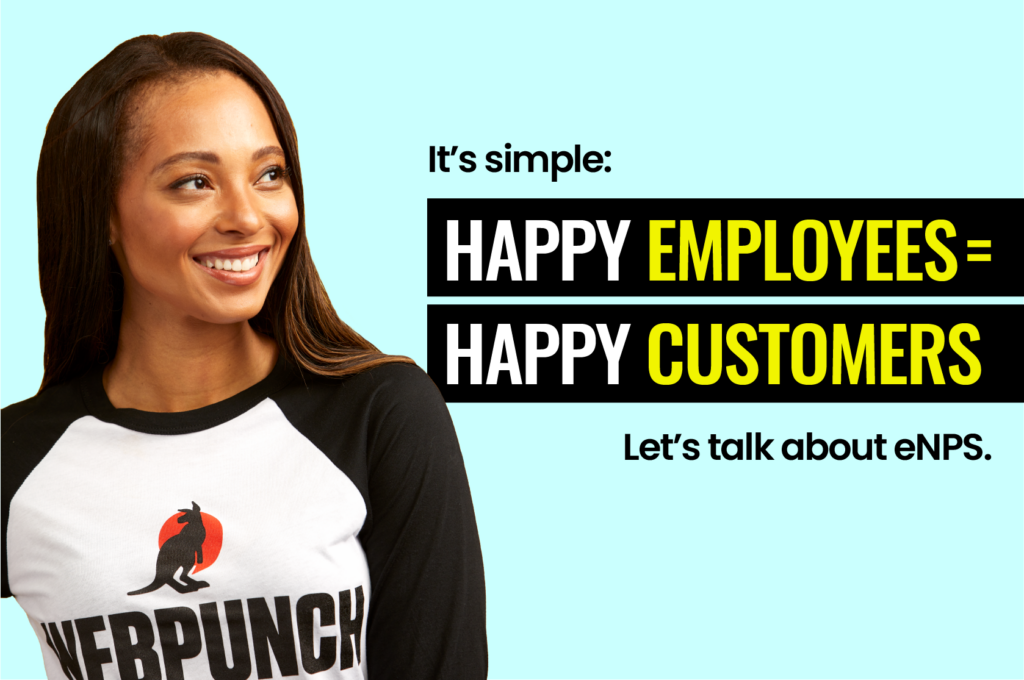We are usually more critical of ourselves than other people are of us. In the mirror my “dad bod” looks to me more like Mr. Chub-a-lub than others (at least that’s what they’ve told me!). To you, your communication skills may be lacking more than your co-workers think they are. That canvas you painted is missing everything and may never be perfect, but collectors are pining for it. A company’s employees will point out faults of their employers more often and harsher than its customers will.
And that is a problem.
As we know, low employee sentiment and overall workplace morale means low employee engagement, leading to a negative customer experience and fleeting customer loyalty—not a fun ripple effect.
Enter Employee Net Promoter Score®, or eNPS® for short.
eNPS® is similar to the famed Net Promoter Score® we’ve talked so much about, but it’s for internal employees. When employees are unhappy, that translates directly to the customer experience and overall feel of a business.
Happy employees means happy customers because they add to that experience immensely. They provide that experience completely. It’s hard for someone who is unhappy at their job to put on a smile and work with customers on behalf of the company they’re simultaneously begrudging.
Further miring the problem, if employees take to the airwaves on sites like Glassdoor.com and Indeed.com to air out their qualms, well the brand has another thing coming. That online feedback can be just as consequential, if not more, to a brand as customers complaining about them online, undermining any positive, public story line by the company.
“In short, engaged employees play a vital role in creating customer promoters.” -Bain and Company article, The Employee Net Promoter System®.
eNPS® calls for company leaders to gauge employee sentiment by requesting feedback from them. Not only will this help point out the shortcomings in workforce operations, but it also pinpoints the enthusiastic employees. Company leaders can then work to cut out the negative aspects of their workforce and nurture the positives aspects, both of which can be contagious among co-workers.
The process is similar to calculating a brand’s NPS®:
- Request private, but honest feedback with a survey
- Analyze feedback, targeting promoters, passives, and detractors
- Ask the promoters for additional feedback and ask that they review the brand
- Request additional feedback from detractors and passives to understand why they are unhappy and what can be done differently
- Implement changes and return to passives and detractors for feedback and make sure the reason for their complaints have been fixed
However, Bain & Company, who has the patent on NPS® with Fred Richheld, suggests some tweaks. For example, when sorting out promoters, detractors and passives, ask a follow-up question such as “Would you refer this company’s products or services to your friends or families” after asking them to rate the company from one to ten to get a better read of how they feel about the brand they work for.
eNPS® surveys should be shorter than traditional Net Promoter® and annual employee surveys. At the same time, follow-up questions need to be included, because they don’t encourage follow-up questions via phone calls. The eNPS® surveys should be a one-stop assessment as opposed to multiple rounds of questions. It continues:
Although they can be very useful to the executive team, the primary purpose of these surveys is not merely to help headquarters identify and solve everyone’s problems. Instead, they are designed first and foremost to help teams and team leaders recognize and prioritize issues.
Frequency and speed of action are also adjusted. Companies will send out surveys in such a manner that company leaders have a consistent stream of information coming in about their workplace’s sentiment. For example, some may survey employees regularly, but in staggered groups so the same employee isn’t getting surveys all the time. Or, maybe they’ll request feedback from a new employee and then yearly after that.
Analysis of the information should also be much shorter than regular NPS® surveys. Instead of bringing in a third party, companies will share the anonymous information with leaders, supervisors, and department managers so they can make changes accordingly.
The article finishes with a fair warning:
“Employee Net Promoter Scores can be substantially lower than customer scores. Employees often hold their company to even higher standards than do customers. So before you initiate the employee survey process, be ready to process some tough feedback and respond with appropriate action.”
This shouldn’t let brands hold back, however, from gathering crucial information that will help them run more efficiently inside and out.


